Comments / Questions (109)
![]() Christelle wrote:
Christelle wrote:
Bonjour , où peut on se procurer les explications du bonnet pour un bébé 0/3 mois. Cdlt
11.11.2025 - 18:56DROPS Design answered:
Bonjour Christelle, vous trouverez les explications de ce bonnet en taille 1/3 mois (1ère taille, nous n'avons pas plus petit), ici. Bon tricot!
12.11.2025 - 16:22
![]() Karolina wrote:
Karolina wrote:
Czy macie może wersję dla szydełka?
31.10.2025 - 14:39DROPS Design answered:
Witaj Karolino, za wzór możesz wziąć wzór DROPS Baby 45-11. Więcej czapeczek na szydełku znajdziesz TUTAJ. Pozdrawiamy!
02.11.2025 - 19:17
![]() Jennie wrote:
Jennie wrote:
Hej. Jag stickar jordgubbsmössan nu🤗Men jag förstår inte i mönstret hur jag ska få till det gröna innan själva kvisten?? Vänlig hälsning Jennie.
19.08.2025 - 14:22DROPS Design answered:
Hej Jennie. Det gröna innan kvisten stickas i diagram M.2, så följ bara beskrivningen så kommer det att bli som på bilden. Mvh DROPS Design
20.08.2025 - 14:13
![]() Vickie wrote:
Vickie wrote:
Opskrift til voksen på jordbærhue. Findes den. Venligst fra Vickie
04.07.2025 - 16:39DROPS Design answered:
Hei Vickie. Ta en titt på Frosty Berry luen i DROPS 204-39 og juster den slik at den blir lik jordbær luen. Evnt. om det er et lite "voksen" hode der hodemålet er 52 cm , så ta en titt på Berry Bonnet i DROPS Baby 10-26 eller 10-23. mvh DROPS Design
07.07.2025 - 10:44
![]() Justina Marie Hasselbalch wrote:
Justina Marie Hasselbalch wrote:
Kan man strikke den på en anden måde end med strømpepinde?
23.06.2025 - 12:34DROPS Design answered:
Hei Justina. Har du en kort rundpinne kan det brukes eller bruk Magic loop teknikken, i alle fall før man feller mange masker mot slutten. mvh DROPS Design
23.06.2025 - 13:12
![]() Caroline Chapman wrote:
Caroline Chapman wrote:
Hi! I knitted the 10cm x 10cm swatch to get the correct sizing and had to go up to a 3.5mm needle to get the correct gauge. Now I'm knitting the smallest size hat for my soon to be born grandchild and it seems to be very big. Has anyone else checked the gauge and found the same or am I doing something wrong? Thank you, Caroline
27.05.2025 - 17:13DROPS Design answered:
Dear Caroline, with 26 sts for 10 cm, the 108 sts in first size should measure approx. 41,5 cm to fit the circumference of head 40/42 cm; make sure you are keeping same tension in the round as when working the swatch. Happy knitting!
28.05.2025 - 07:53
![]() Bärbel Hammes wrote:
Bärbel Hammes wrote:
Mit viel Freude habe ich diese Mütze gestrickt. Ich habe vorhandene Wollreste verwendet, die etwas dicker waren als die vorgegebene Wolle, es hat trotzdem super funktioniert. Ich habe einfach die Maschenzahl anhand der Maschenprobe umgerechnet. Muster 1 habe ich nicht gestrickt, sondern die Maschen im Nachhinein im Maschenstich aufgestickt. Mir gefällt es so besser und ich hoffe meiner Enkeltochter auch, ihr Mama hat sich die Mütze gewünscht. Dank für die tolle Anleitung!!
16.05.2025 - 17:00
![]() Karin Groth Andersen wrote:
Karin Groth Andersen wrote:
.............................................................................................................................
20.04.2025 - 13:29
![]() 🇳🇴Beth wrote:
🇳🇴Beth wrote:
Har strikket en jordbærlue i str 2-3/4 år,den ble knall😊🫶Nå skal jeg strikke en blåbærlue i str 12/18 mnd. Takk for flott oppskrift
06.03.2025 - 21:50
![]() Mona wrote:
Mona wrote:
Beskrivningen är väldigt otydlig på slutet vid minskningen när det står minska tills det återstår 14m på st. Och sedan minska 6m jämnt fördelat = 8m på stickan. Man tyder som det ska vara på varje sticka fast det ska vara på varvet. Det borde ni ändra!
11.01.2025 - 20:56
Sweet Strawberry#sweetstrawberryhat |
||||||||||
|
|
||||||||||
Knitted strawberry hat for baby and children in DROPS Alpaca
DROPS Baby 21-21 |
||||||||||
|
PATTERN: See diagrams M.1 and M.2. ---------------------------------------------------------- HAT: Worked in the round. Loosely cast on 108-114-120 (126-132) sts on double pointed needles size 2.5 mm / US 1or2 with red or graypurple (no of sts divisible by 6, distribute sts evenly on 4 double pointed needles). P 1 round, then work in stockinette st. REMEMBER THE GAUGE! When piece measures 5-5-6 (6-7) cm / 2"-2"-2⅜" (2⅜"-2¾") work diagram M.1. After diagram M.1 has been worked 2 times vertically, work rounds 1-7 in diagram M.1, then K 1 round with red while at the same time dec 4-2-0 (6-4) sts evenly = 104-112-120 (120-128) sts (no of sts divisible by 8). Piece now measures approx. 13-13-14 (14-15) cm / 5⅛"-5⅛"-5½" (5½"-6"). Then work diagram M.2 1 time vertically, and then finish the piece with dark olive. Now insert 13-14-15 (15-16) markers in the piece 8 sts apart. Then dec 1 st on left side of all markers (by K 2 tog) on every other round until 13-14-15 (15-16) sts remain on needles. Knit 1 round where you decrease 5-6-7-7-8 sts evenly spaced = 8 sts on needles. Piece now measures approx. 18-18-19 (20-21) cm / 7"-7"-7½" (8"-8¼"). Work in the round for 3 cm / 1⅛" over these sts for "stem". Pull a double thread through the remaining sts and fasten tightly. |
||||||||||
Diagram explanations |
||||||||||
|
||||||||||
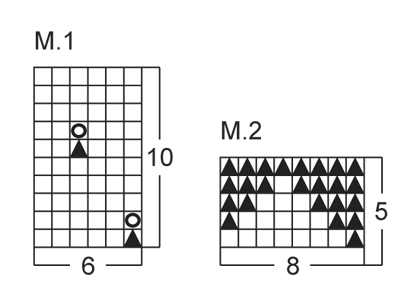 |
||||||||||
Have you finished this pattern?Tag your pictures with #dropspattern #sweetstrawberryhat or submit them to the #dropsfan gallery. Do you need help with this pattern?You'll find 6 tutorial videos, a Comments/Questions area and more by visiting the pattern on garnstudio.com. © 1982-2025 DROPS Design A/S. We reserve all rights. This document, including all its sub-sections, has copyrights. Read more about what you can do with our patterns at the bottom of each pattern on our site. |
||||||||||















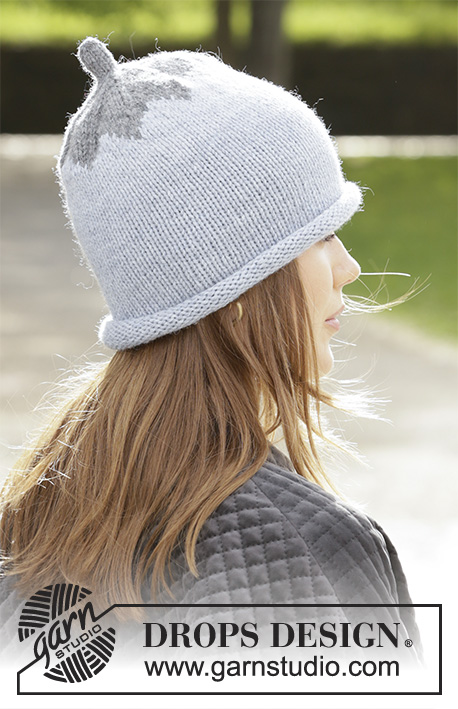























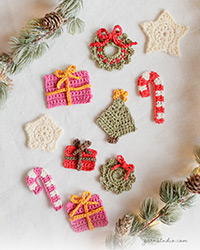
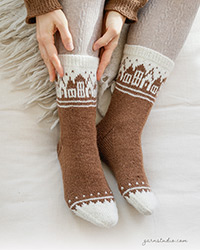

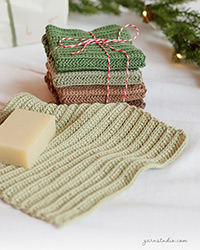


Post a comment to pattern DROPS Baby 21-21
We would love to hear what you have to say about this pattern!
If you want to leave a question, please make sure you select the correct category in the form below, to speed up the answering process. Required fields are marked *.